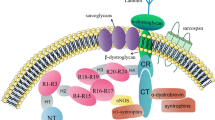Summary
The pathogenesis of mitochondrial disorders has largely focused on the impairment of cellular energy metabolism. However, mitochondrial dysfunction has also been implicated as a factor in the initiation of apoptosis due to the translocation of cytochrome c, from mitochondria to the cytosol, and the subsequent cleavage of pro-caspase 3. In this study, we determined the cytochrome c content of cytosols (skeletal muscle) prepared from 22 patients with evidence of compromised mitochondrial electron transport chain enzyme activity and 26 disease controls. The cytochrome c content of the mitochondrial electron transport chain-deficient group was found to be significantly (p < 0.02) elevated when compared with the control group (63.7 ± 15.5 versus 27.7 ± 2.5 ng/mg protein). Furthermore, a relationship between the cytosolic cytochrome c content of skeletal muscle and complex I and complex IV activities was demonstrated. Such data raise the possibility that mitochondrial cytochrome c release may be a feature of mitochondrial disorders, particularly for those patients with marked deficiencies of respiratory chain enzymes. Whether initiation of apoptosis occurs as a direct consequence of this cytochrome c release has not been fully evaluated here. However, for one patient with the greatest documented cytosolic cytochrome c content, caspase 3 could be demonstrated in the cytosolic preparation. Further work is required in order to establish whether a relationship also exists between caspase 3 formation and the magnitude of respiratory chain deficiency.

Similar content being viewed by others
Abbreviations
- ETC:
-
electron transport chain
- mtDNA:
-
mitochondrial DNA
- SEM:
-
standard error of the mean
References
Brustovetsky N, Dubinsky JM, Antonsson B, Jemmerson R (2003) Two pathways for tBID-induced cytochrome c release from rat brain mitochondria: BAK versus BAX dependence. J Neurochem 84: 196–207. doi:10.1046/j.1471-4159.2003.01545.x.
Clayton R, Clark JB, Sharpe M (2005) Cytochrome c release from rat brain mitochondria is proportional to the mitochondrial functional deficit: implications for apoptosis and neurodegenerative disease. J Neurochem 92: 840–849. doi:10.1111/j.1471-4159.2004.02918.x.
Davey GP, Clark JB (1996) Threshold effects and control of oxidative phosphorylation in nonsynaptic rat brain mitochondria. J Neurochem 66: 1617–1624.
Goodsell DS (2004) The molecular perspective; cytochrome c and apoptosis. Oncologist 9: 226–227.
Heales SJ, Gegg ME, Clark JB (2002) Oxidative phosphorylation: structure, function, and intermediary metabolism. Int Rev Neurobiol 53: 25–56. doi:10.1016/S0074-7742(02)53003-8.
Jacobson J, Duchen MR (2001) ‘What nourishes me, destroys me’: towards a new mitochondrial biology. Cell Death Differ 8(10): 963–966. doi:10.1038/sj.cdd.4400911.
King TE (1967) Preparations of succinate-cytochrome c reductase and the cytochrome b-c 1 particle, and reconstitution of succinate-cytochrome c reductase. Methods Enzymol 10: 216–225.
Lowry OH, Rosebrough NJ, Farr AL, Randall RJ (1951) Protein measurement with the Folin phenol reagent. J Biol Chem 193: 265–275.
Mirabella M, Di Giovanni S, Silvestri G, Tonali P, Servidei S (2000) Apoptosis in mitochondrial encephalomyopathies with mitochondrial DNA mutations: a potential pathogenic mechanism. Brain 123: 93–104. doi:10.1093/brain/123.1.93.
Ott M, Robertson JD, Gogvadze V, Zhivotovsky B, Orrenius S (2002) cytochrome c release from mitochondria proceeds by a two step process. Proc Natl Acad Sci U S A 99: 1259–1263. doi:10.1073/pnas.241655498.
Ragan CI, Wilson MT, Darley-Usmar VM, et al (1987) Subfractionation of mitochondria and isolation of the proteins of oxidative phosphorylation. In: Darley-Usmar VM, Rickwood D, Wilson MT, eds. Mitochondria, a Practical Approach. London: IRL Press, 79–112.
Selak MA, de Chadarevian JP, Melvin JJ, Grover WD, Salganicoff L, Kaye EM (2000) Mitochondrial activity in Pompe’s disease. Pediatr Neurol 23: 54–57. doi:10.1016/S0887-8994(00)00145-4.
Shepherd D, Garland PB (1969) The kinetic properties of citrate synthase from rat liver mitochondria. Biochem J 114: 597–610.
Shimizu S, Ide T, Yanagida T, Tsujimoto Y (2000) Electrophysiological study of a novel large pore formed by Bax and the voltage dependent anion channel that is permeable to cytochrome c. J Biol Chem 275: 12321–12325. doi:10.1074/jbc.275.16.12321.
Skulachev VP (1998) Cytochrome c in the apoptotic and antioxidant cascades. FEBS Lett 423: 275–280. doi:10.1016/S0014-5793(98)00061-1.
Umaki Y, Mitsui T, Endo I, Akaike M, Matsumoto T (2002) Apoptosis-related changes in skeletal muscles of patients with mitochondrial diseases. Acta Neuropathol 103: 163–170. doi:10.1007/s004010100446.
Vassault A (1983) l-Lactate dehydrogenase. UV method with pyruvate and NADH. In: Bergmeyer J, Grassl M, eds. Methods of Enzymic Analysis, Vol. 3. Weinheim: Verlag Chemie GmbH, 118–126.
Wharton DC, Tzagoloff A (1967) Cytochrome oxidase from beef heart mitochondria. Methods Enzymol 10: 245–250[Abstract]. doi:10.1016/0076-6879(67)10048-7.
Zamaraeva MV, Sabirov RZ, Maeno E, Ando-Akatsuka Y, Bessonova SV, Okada Y (2005) Cells die with increase cytosolic ATP during apoptosis: a bioluminescence study with intracellular luciferase. Cell Death Differ 12: 1390–1397.
Author information
Authors and Affiliations
Corresponding author
Additional information
Communicating editor: Wolfgang Sperl
Competing interests: None declared
Rights and permissions
About this article
Cite this article
Oppenheim, M.L.S., Hargreaves, I.P., Pope, S. et al. Mitochondrial cytochrome c release: a factor to consider in mitochondrial disease?. J Inherit Metab Dis 32, 269–273 (2009). https://doi.org/10.1007/s10545-009-1061-8
Received:
Revised:
Accepted:
Published:
Issue Date:
DOI: https://doi.org/10.1007/s10545-009-1061-8




